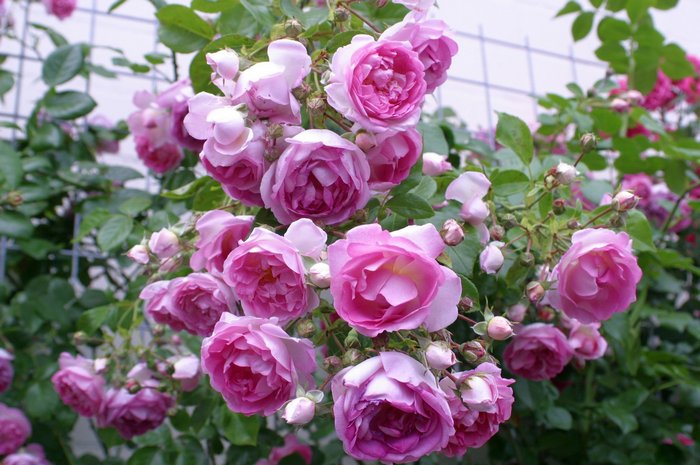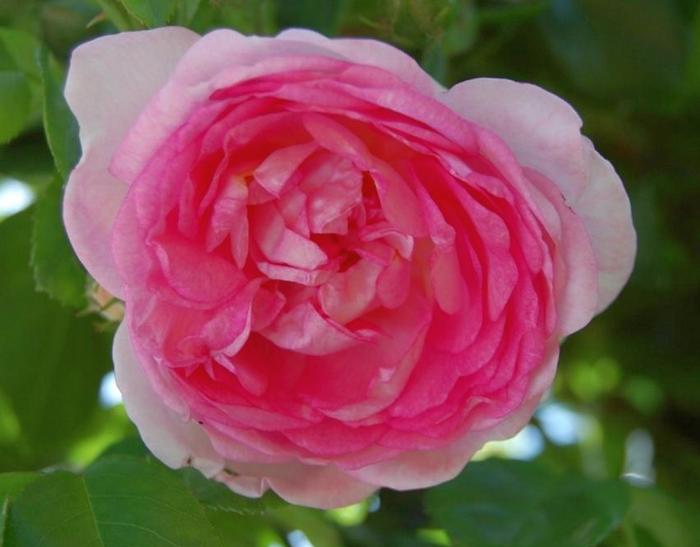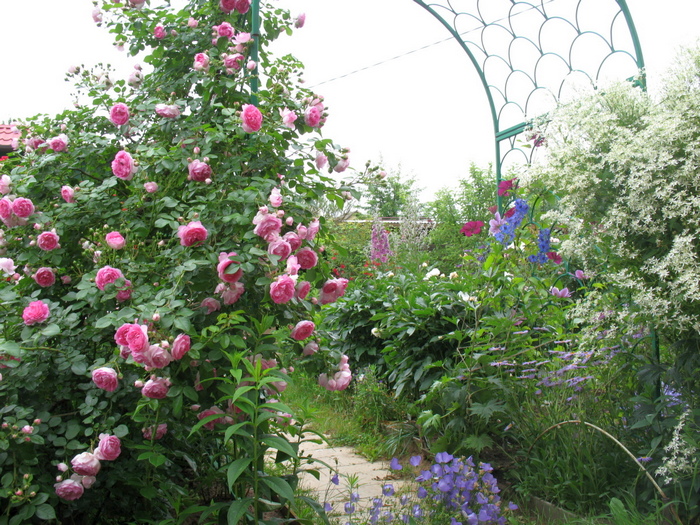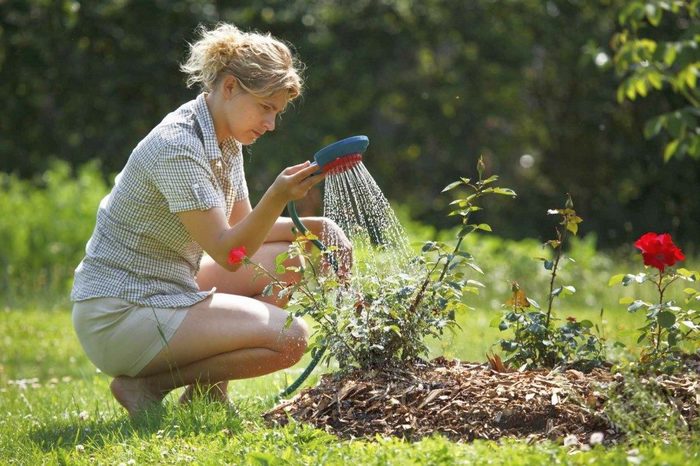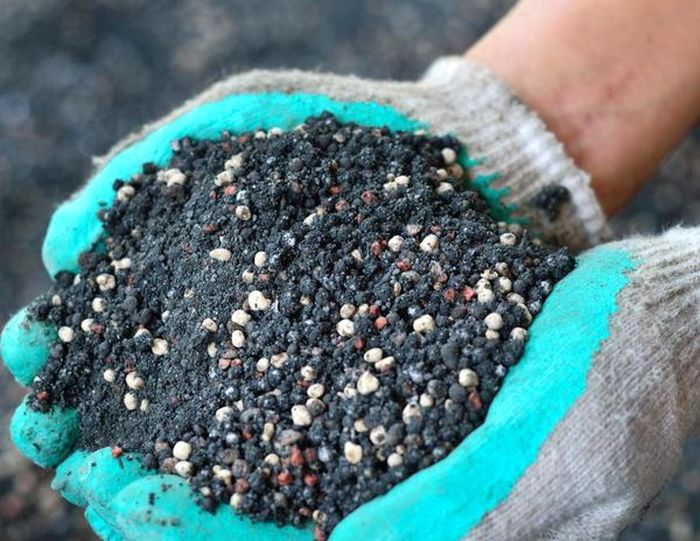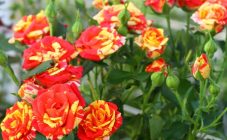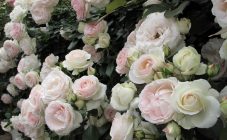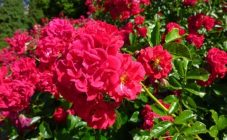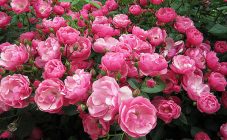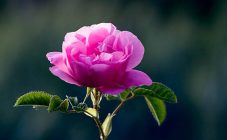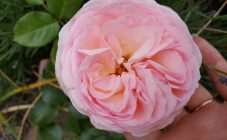Content:
Climbing roses are some types of rose hips and varieties of garden roses with long, creeping or hanging shoots. These roses are distinguished by a variety of varieties and hybrid forms: there are varieties that bloom once a year, as well as remontant, small-flowered and large-flowered, curly, climbing, semi-climbing. Today climbing roses occupy one of the leading places in the field of vertical gardening.
Climbing rose Jasmine is considered one of the most popular subspecies.
The history of the creation of the Jasmine rose variety
Rose of Jasmine (also rose of Yasmine) is a climber, a relatively young hybrid strongly branched variety with racemose flowering. It was bred in Germany in 2005 by crossing a seedling with a Centenaire de Lourdes scrub (Santener de Lurd).
This variety belongs to the category of "nostalgic roses", as their appearance is stylized to the popular English roses. The Yasmin rose is grown primarily as a decorative element in vertical gardening.
Characteristics and features of the variety
Jasmine (Jasmina) rose is a branched shrub, reaching an average of 2 m in height. In regions with low temperatures, the growth of the bush at best is 1-1.5 m, but in the south of Russia, the Yasmin rose, with good care, grows up to 3 m.The diameter of the plant is about 1-1.2 m.
The hybrid blooms profusely (2 times per season), and the flowering is greatly extended in time. The first buds appear on last year's shoots in June
The leaves of the shrub are dark, smooth, shiny, densely located on the stem. Shoots are very thorny and tough.
The flowers are painted in a pale pink lavender tone. When fully opened, the Jasmine rosebuds resemble small cups in their appearance. Dense double petals. The diameter of the flowers is 6-7 cm. They form inflorescences of 8-14 pieces.
The light, sweet honey aroma of the variety is especially distinguished, in which notes of apple and vanilla are clearly felt. In 2007 rose Yasmina won the prize for a unique fragrance in the Knight Rose Competition (France).
The description of the variety also emphasizes its resistance to many diseases.
Agrotechnics
The rules for planting the Jasmine bush rose and the subsequent care of the plant are not particularly difficult. The variety is not picky about the type of soil, and also does not need frequent feeding and pruning. One of the few weaknesses of the hybrid is its vulnerability to strong winds, which is why it is not recommended to plant it on the corners of buildings.
Illumination requirements
When choosing a site for planting, you should focus on moderately shaded areas. In the open sun, the bush can burn, however, in conditions of diffused lighting, the plant develops as well as in partial shade.
Requirements for soil quality
Rose Jasmine grows well on almost all types of soil, but clay or light sandy soil will not be superfluous to fertilize with humus or peat. Also, the plant does not take root well on waterlogged waterlogged soils.The most favorable site for planting this variety is weakly acidic fertile soil.
Watering
The variety is considered to be quite drought-resistant, but watering is required during particularly hot periods. Each bush takes an average of 20 liters of warm settled water. Optimum watering frequency: 2 times a week in conditions of prolonged drought. In August, plants are watered less often, and with the beginning of autumn, watering is stopped altogether. It is also not recommended to water roses in rainy weather, as high soil moisture can provoke the development of fungal diseases.
Landing algorithm
Yasmin's rose is usually planted in late September - early October. In areas with a cold climate, the variety is planted in the spring (April - May). So the seedlings will have time to take root before the onset of the first frost.
When planting a plant, you should adhere to the following recommendations:
- The depth of the planting hole for the bush should be 50-60 cm in depth, diameter - 50 cm.
- A small peg (80-100 cm high) is driven into the bottom of the pit, which will serve as a support for the seedling, after which the hole is covered with a layer of drainage from gravel or small pebbles. Optimum layer thickness: 8-10 cm.
- Organic fertilizers are poured over the drainage layer - you can use rotted manure or compost, also with a layer of no more than 10 cm.
- A small mound from the top fertile layer of earth is laid out on a fertilizer pillow, on which the seedling is then placed. When the bush is deepened, it is placed not perpendicular to the ground, but at an angle of 30 ° to the support. The root collar should rise at least 3 cm above the soil level.
- The hole is covered with earth and lightly tamped, after which it is watered abundantly at the very root, avoiding moisture on the leaves.
- The planting procedure is completed by mulching the root area of the soil with peat.
Formation of bushes
Rose Jasmine does not need regular pruning, so the procedure is purely cosmetic. The plant is usually cut in the spring, when the first buds swell. On average, 5 buds are left on each shoot. The rest of plant care is reduced to loosening the soil and removing weeds around the bush.
Top dressing
Fertilizing under the bush is optional, but the variety responds well to feeding. It should be borne in mind that in the spring the rose is fed with nitrogen for a better set of green mass, and in the summer with potassium and phosphorus.
Shelter for the winter
Despite the high frost resistance, roses need to be covered for the winter, but you should not rush with this. The first frosts can be skipped - they cover the bushes only with the onset of constant cold weather.
The next step is to remove the props. The bush is bent to the ground, placing spruce or pine branches under it. An arched frame is installed over the rose, on which any suitable material for shelter is stretched.
Reproduction
The Jasmine variety is propagated by cuttings. Cuttings are harvested from young, but strong plants after the first flowering. Before planting, a stem is formed from cuttings of roses.
Advantages and disadvantages of the variety in comparison with other varieties
The following advantages of the Jasmina rose are distinguished:
- large size, branching and a tall bush - thanks to these characteristics, the variety looks good when compiling vertical spatial compositions;
- abundant and long flowering;
- unusual aroma with a touch of apples and vanilla;
- decorative cup-shaped buds;
- high frost resistance;
- relative unpretentiousness;
- moderate drought resistance;
- endurance and immunity to diseases such as powdery mildew and black spot - the Jasmine rose rarely and a little sick.
The disadvantages of the hybrid include vulnerability to heavy rains - heavy drops can crush the buds and leaves of the plant. However, the "mushroom" rains are nothing to the variety.
Today, the climbing rose Yasmina occupies one of the leading places in vertical gardening - the branched bushes of the variety go well with small architectural forms. Also, Jasmine roses are indispensable when creating decorative columns, pyramids, arches, trellises, green decoration of walls of buildings, balconies, and arbors.
